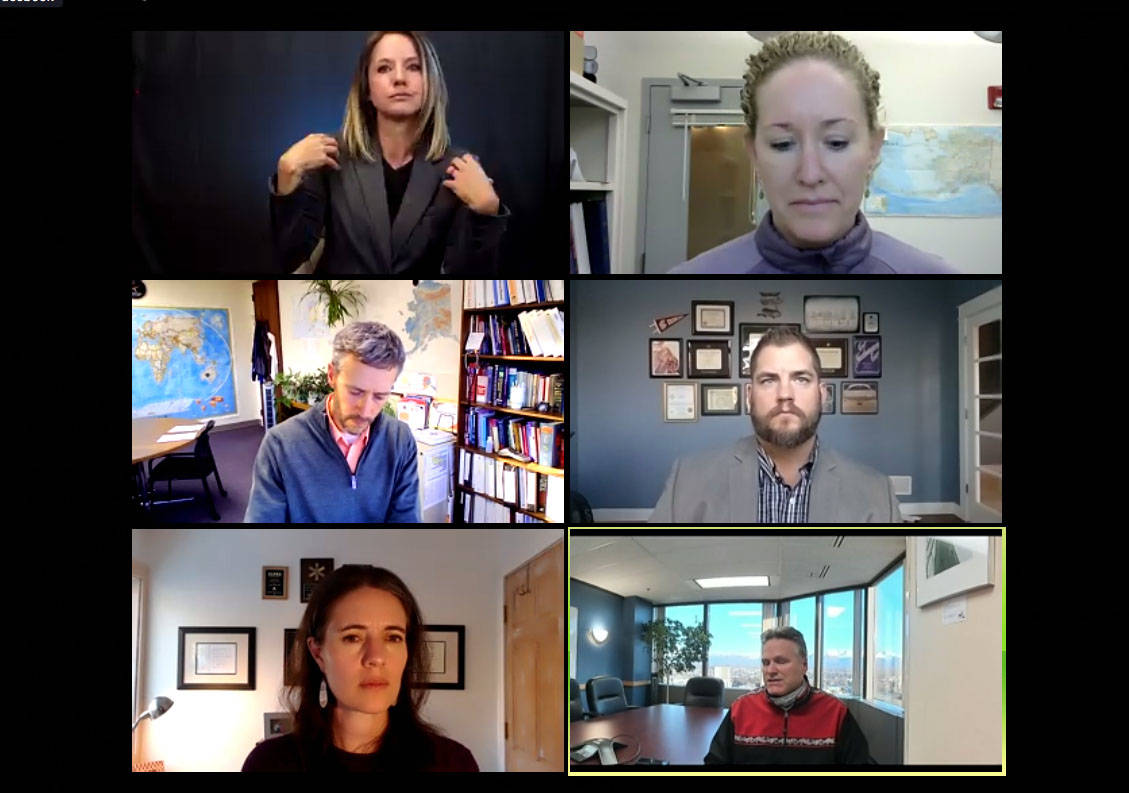On the 28th consecutive day of triple-digit COVID-19 case numbers in Alaska, Gov. Mike Dunleavy and members of his administration on Wednesday addressed the state’s most recent surge in infections.
The press conference — the first Dunleavy has held to address the pandemic since Sept. 1 — was attended by Public Health Director Heidi Hedberg, Dr. Joe McLaughlin, chief of the Alaska Section of Epidemiology, Adam Crum, commissioner of the Alaska Department of Health and Social Services, and Chief Medial Officer Dr. Anne Zink.
“We always knew that virus cases were going to rise,” Dunleavy said, echoing a statement he has made consistently throughout the pandemic. “We just knew, because it’s a highly, highly infectious disease. Some have said this is one of the most contagious viruses they’ve dealt with in decades.”
Dunleavy pointed to a rise in cases around the world, especially in countries that have attempted to reopen their economy. Dunleavy also noted that there is good news from the trends in recent months, including a decrease in the average length of stay for COVID-19 patients who have been hospitalized. The average stay at Providence Alaska Medical Center in Anchorage was about 6.7 days as of September, compared with 11.8 days in March.
“We’ve learned a lot about the virus,” Dunleavy said. “We’ve learned a lot about how to deal with the virus. The medical community has learned a lot on how to deal with patients. And so, although our cases are going up, we’re seeing a decrease in hospitalization stays. We’re seeing a decrease in the death rate, and we’re seeing a decrease in overall hospitalizations.”
Watch Wednesday’s press conference in its entirety here:
There are 41 COVID patients hospitalized across Alaska as of Wednesday’s report from the Department of Health and Social Services, eight of whom require treatment on ventilators.
During a hearing Tuesday with Alaska’s House Health and Social Services Committee, health care professionals testified that Alaska’s health care system is at risk of being overwhelmed if the rate of new infections continues at its current rate.
“The recent increase in COVID-19 illnesses in Alaska is very concerning and could pose a threat to our health care system if rates increase further,” Dr. Tom Hennessy, infectious disease epidemiologist with the University of Alaska Anchorage, said during Tuesday’s hearing. “The current rate of transmission could be reversed if Alaskans increased our use of facial masks, maintained physical distancing, avoided closed indoor spaces and increased hand-washing. Public messages and/or public policies that promoted these basic steps could reverse the current upward trend and save lives.”
No one from the Department of Health and Social Services participated in Tuesday’s hearing. When asked at the Wednesday briefing why that was the case, Commissioner Adam Crum cited a schedule conflict.
“Competing schedules,” Crum said. “There’s a lot going on, and we have meetings on the books all the time. Yesterday at that time I was doing a press conference with Division of Elections talking about the Vote Safe 907 initiative.”
Crum added that the state is in communication with those who testified on a regular basis to exchange information, and emphasized that “everyone is on the same team,” but did not say whether he agreed with the comments made during the hearing.
“We have a lot of items that we are working on,” Crum said. “We try to test for what are the best options for us to actually protect Alaskans going forward — what are certain items that we’re seeing in different areas — and we’re in constant conversation with those groups. All of those suggestions, all those items, we throw off the wall to each other all the time. Measuring them, seeing how they work in Alaska and different areas of the state, and how they’ve worked around the country.”
Dunleavy was asked why he opened the press conference by speaking “reassuringly” about the severity of Alaska’s COVID-19 situation, given that the rise in cases in rural Alaska has been noted as a cause of concern by state epidemiologists. Dunleavy said he was not attempting to downplay the situation, but reiterated that the recent rise did not come as a surprise.
“I don’t want anyone thinking as a result of the question that we are somehow misrepresenting what’s occurring in the state,” Dunleavy said. “We start out by saying that cases are growing. We’ve shown all the data. We’ve shown charts. We made a commitment to the people of Alaska when this pandemic hit that we were going to be as open and transparent as we possibly can.”
Reach reporter Brian Mazurek at bmazurek@peninsulaclarion.com.
This story has been updated to correct the spelling of Public Health Director Heidi Hedberg’s last name.

